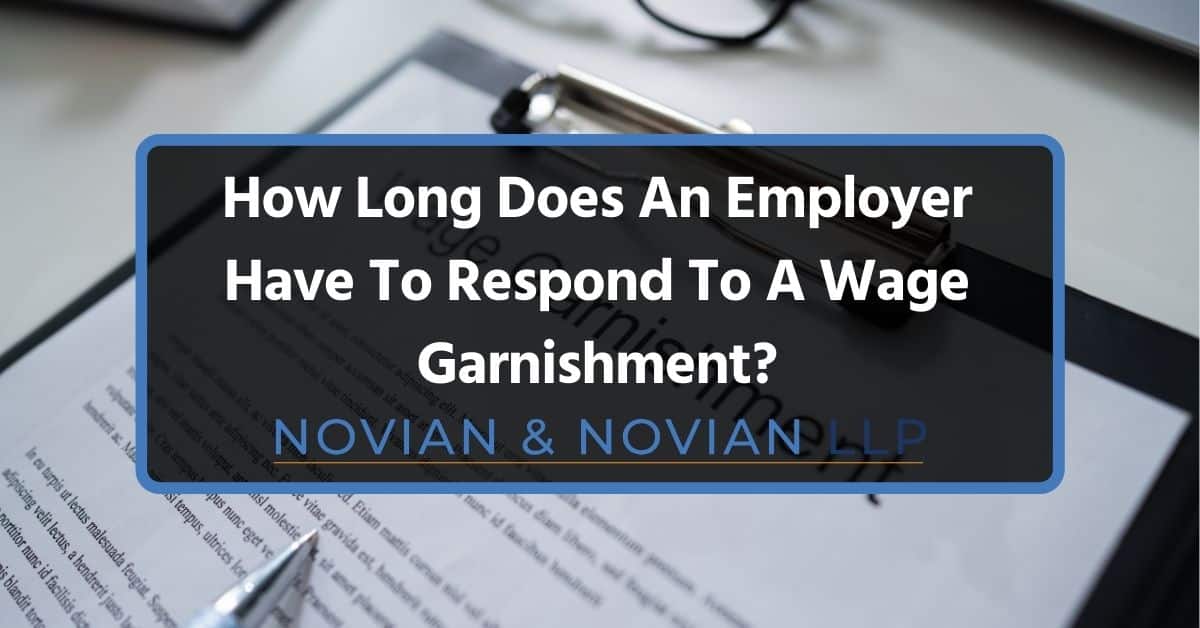
by | Feb 12, 2024 | Employment Law
Disclaimer: While this website and our blog provide general information, it does not constitute legal advice. For this article, the focus is on wage garnishment.
Wage garnishment is a legal process where the court orders an employer to take out a portion of an employee’s earnings to satisfy a debt the employee owes. While it might sound like an easy action to carry out, it comes with its complexities as it might be seen as a breach of contract.
As an employer, you must understand all the intricacies of wage garnishment, including the potential repercussions in cases of non-compliance. In such situations, you may face legal penalties, financial liabilities, and damage to your company’s reputation.
If you’re an employer struggling with the complexities of wage garnishment, we are here for you! At Novian & Novian, we have a team of expert lawyers who guide employers through the legal waters with confidence.
With over 35 years of experience in employment law, you can be sure that we have the interest of your business at heart! Contact us today to learn more about how we can support you.
In this article, we aim to equip employers with the knowledge and tools to manage wage garnishment efficiently and legally and educate employees. The goal is to ensure that you know all angles of wage garnishment and safeguard your business.
How Long Does an Employer Have to Respond to a Wage Garnishment?
A wage garnishment order is a system put in place to recover debts directly from an individual’s income. Here, an employer gets a court order to withhold a portion of an employee’s wages to pay off the employee’s debt.
You may be wondering, what type of debt leads to an employer getting a wage garnishment? Various debts lead to wage garnishment orders. Income taxes, federal student loans, child support, alimony, and consumer debts such as credit card debt and medical bills are some common debt cases.
How long does an employer have to respond to a wage garnishment order? As an employer, you must act immediately once you receive a wage garnishment order. Generally, garnishment begins by the next pay period after receiving the order. By promptly complying, you’re ensuring compliance with legal mandates and avoiding additional liabilities or penalties.
The process for legally notifying an employee about a wage garnishment order is also governed by federal and state laws. Employers are typically required to provide the employee with a copy of the garnishment order and any other related documents promptly. This notification should inform the employee about the garnishment, how it will affect their earnings, and their rights, including any possible exemptions or challenges they may pursue.
Commencing the wage garnishment process involves calculating the correct amount to withhold from the employee’s disposable earnings. The amount garnished must not exceed the limits set by federal or state laws, which generally protect a portion of the employee’s income to cover basic living expenses.
For example, under federal law, the maximum amount that can be garnished is generally the lesser of 25% of the employee’s disposable earnings or the amount by which their weekly earnings exceed 30 times the federal minimum wage.
Employers must balance compliance with the garnishment order with the need to respect the employee’s legal rights and financial stability. It is why we have put out this informational piece to ensure that you are always on the right side of legal affairs for employment law.
Step-by-Step Compliance for Employers
Paying attention to details is critical for employers when dealing with employment law affairs, including wage garnishments. This is why you must immediately review the document once you receive a wage garnishment order.
Reach through to understand the specifics of the debt, the amount to be garnished, and the deadlines attached to the wage garnishment process. Once you understand everything, you must act quickly and start deducting from the employee’s pay by the next payment cycle.
Keep in mind that you need to inform the affected employee about the garnishment order before making deductions. It would come in handy to provide them with a copy of the order and other relevant documents. It helps to ensure transparency and a healthy working relationship.
Once you’ve understood the document and are satisfied with the terms including informing your employee, you then need to calculate the employee’s disposable earnings. You would do so by subtracting the legally required deductions like local taxes, social security, etc. from their gross earnings. Garnishment should only be removed from disposable earnings.
If the employee has multiple wage garnishment orders, prioritize them according to the applicable federal laws. For example, child support orders usually have priority over other types of debt.
Then, you need to adjust your payroll system to withhold the calculated garnished amount from the employee’s paycheck. You must ensure that this processing is done promptly for each pay period during the duration of the wage garnishment.
Adjust your payroll system to withhold the calculated garnishment amount from the employee’s wages. Ensure accurate and timely processing of these deductions each pay period for the duration of the garnishment order. Your payroll departments must also send the garnished amount to the appropriate court or agency as directed in the garnishment order within the stipulated time frame.
It is important to keep detailed records of the garnishment order, your communications with the employee, the calculations made to determine the garnishment amount, and proof of payments made. They serve as compliance records and can be useful in cases of disputes.
Importantly, you must ensure to protect the employee’s rights throughout the wage garnishment process. Any form of discrimination or retaliation may put you at risk of a legal proceeding filed against you and your organization.
Employer’s Legal Obligations Towards Employees’ Wage Garnishment
As an employer, you must understand that you are the link bridge between the creditor and your employee. It is why you’re being served wage garnishments to ensure that the creditor is paid from the employee’s compensation. Therefore you play a pivotal role in the process.
Under the law, you have a legal responsibility to inform your employee about the garnishment court order. They should be aware of all details, including any possible exemptions and the process for contesting the garnishment. You must also promptly acknowledge and take action on wage garnishments. Since you are the employer, you also have the responsibility to garnish wages/calculate the garnishment funds.
When an employee has multiple wage garnishments, employers must prioritize them according to legal guidelines. You must ensure to balance multiple garnishments while ensuring the employee’s wages do not fall below the federal or state minimum wage.
Non-compliance with wage garnishment orders can have serious repercussions for employers, including financial penalties, legal fees, and damages. Moreover, non-compliance can damage the employer’s reputation, both internally among employees and externally in the marketplace.
Handling Multiple Garnishment Orders
Handling multiple wage garnishments for a single employee presents a complex challenge for employers. It requires careful navigation of legal requirements and strategic prioritization to ensure compliance.
To prioritize garnishment orders for an employee, you must understand the various types of garnishments. Garnishments can arise from various sources like child support, consumer debt, black taxes, etc. The nature of the debt often determines the priority of the garnishment.
Generally, child support orders take precedence over most other types of debt due to federal and state policies prioritizing family welfare. After child support, tax levies issued by the IRS or state tax agencies typically come next, followed by federal student loans and then consumer debts.
If multiple garnishments are for similar types of debt without specific prioritization, the date received the garnishment order as an employer can play a role in determining priority. Earlier orders generally take precedence over those received later.
Mitigating Challenges: Employer Strategies
Some common challenges employers face in processing wage garnishments are:
Addressing Payroll Adjustments
To combat this challenge, you should implement or upgrade payroll software that can automate garnishment calculations and deductions. This reduces errors and ensures compliance with federal and state laws regarding maximum withholding limits and priorities among multiple garnishments.
Regular training for payroll staff can also help. It helps when you keep payroll departments informed about current laws and best practices for handling garnishments.
Managing Employee Dissatisfaction
Keep in mind that confidentiality is key when dealing with garnishments and employee pay. Ensure that you address garnishments with the utmost respect for privacy. Any discussions about garnishment should be held discreetly to protect the employee’s dignity and prevent workplace gossip.
You should also provide support and resources or referrals to financial counseling for employees undergoing garnishment. This can help them manage their financial situation more effectively and potentially stop wage garnishment by negotiating alternative payment plans.
Leveraging Resources and Expertise
As an employer, it is important to seek advice from legal experts specializing in employment law like Novian & Novian. We can help you navigate the complexities of federal and state garnishment laws. Our lawyers offer guidance on responding to garnishment orders, prioritizing multiple garnishments, and ensuring compliance while minimizing liability.
Associations and employer advocacy groups also provide resources and guidance on managing wage garnishments. These can be invaluable for staying updated on legislation changes and best practices.
In addition, it would be helpful to Invest in training for HR and payroll personnel on the nuances of wage garnishment, including handling garnishments for employees with multiple financial obligations and ensuring compliance with court orders and federal and state laws.
Wage Garnishments and Legal Compliance with Novian & Novian
Being proactive and well-informed is essential for navigating these waters successfully. We encourage employers to actively engage with the challenges and solutions surrounding wage garnishments. Share your experiences and seek advice in the comments. Also, join a community of professionals navigating similar issues.
Novian & Novian can guide you to a variety of legal issues, including a wage garnishment process. Contact us now, and let us provide the expertise you need!
Contact Us
Have questions about this post? Novian & Novian is a full service law firm in Los Angeles with clients that span the country. Contact us today for a free consultation.
Contact Us
Have questions about this post? Novian & Novian is a full service law firm in Los Angeles with clients that span the country. Contact us today for a free consultation.




